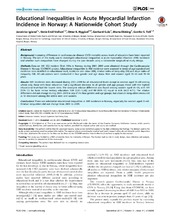| dc.contributor.author | Igland, Jannicke | en_US |
| dc.contributor.author | Vollset, Stein Emil | en_US |
| dc.contributor.author | Nygård, Ottar | en_US |
| dc.contributor.author | Sulo, Gerhard | en_US |
| dc.contributor.author | Ebbing, Marta | en_US |
| dc.contributor.author | Tell, Grethe Seppola | en_US |
| dc.date.accessioned | 2015-01-05T06:48:39Z | |
| dc.date.available | 2015-01-05T06:48:39Z | |
| dc.date.issued | 2014-09-04 | eng |
| dc.identifier.issn | 1932-6203 | |
| dc.identifier.uri | https://hdl.handle.net/1956/9064 | |
| dc.description.abstract | Background Increasing differences in cardiovascular disease (CVD) mortality across levels of education have been reported in Norway. The aim of the study was to investigate educational inequalities in acute myocardial infarction (AMI) incidence and whether such inequalities have changed during the past decade using a nationwide longitudinal study design. Methods Data on 141 332 incident (first) AMIs in Norway during 2001–2009 were obtained through the Cardiovascular Disease in Norway (CVDNOR) project. Educational inequalities in AMI incidence were assessed in terms of age-standardised incidence rates stratified on educational level, incidence rate ratios (IRR), relative index of inequality (RII) and slope index of inequality (SII). All calculations were conducted in four gender and age strata: Men and women aged 35–69 and 70–94 years. Results AMI Incidence rates decreased during 2001–2009 for all educational levels except in women aged 35–69 among whom only those with basic education had a significant decrease. In all gender and age groups; those with the highest educational level had the lowest rates. The strongest relative difference was found among women aged 35–69, with IRR (95% CI) for basic versus tertiary education 3.04 (2.85–3.24)) and RII (95% CI) equal to 4.36 (4.03–4.71). The relative differences did not change during 2001–2009 in any of the four gender and age groups, but absolute inequalities measured as SII decreased among the oldest men and women. Conclusions There are substantial educational inequalities in AMI incidence in Norway, especially for women aged 35–69. Relative inequalities did not change from 2001 to 2009. | en_US |
| dc.language.iso | eng | eng |
| dc.publisher | PLoS | eng |
| dc.rights | Attribution CC BY | eng |
| dc.rights.uri | http://creativecommons.org/licenses/by/4.0 | eng |
| dc.title | Educational inequalities in acute myocardial infarction incidence in Norway: A nationwide cohort study | en_US |
| dc.type | Peer reviewed | |
| dc.type | Journal article | |
| dc.date.updated | 2015-01-05T06:42:45Z | |
| dc.description.version | publishedVersion | en_US |
| dc.rights.holder | Copyright 2014 Igland et al | |
| dc.source.articlenumber | e106898 | |
| dc.identifier.doi | https://doi.org/10.1371/journal.pone.0106898 | |
| dc.identifier.cristin | 1175536 | |
| dc.source.journal | PLoS ONE | |
| dc.source.40 | 9 | |
| dc.source.14 | 9 | |

